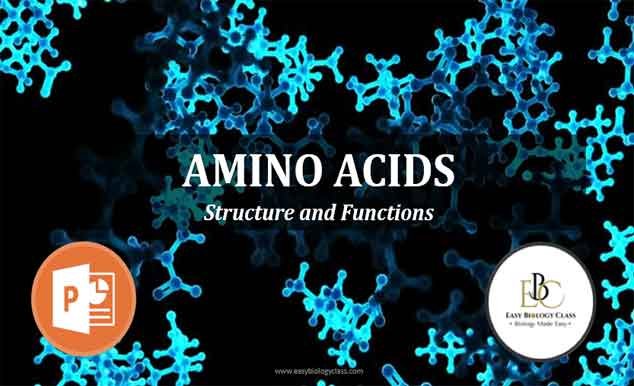Structure of Amino Acids PPT: Amino acids are organic compounds that serve as the building blocks of proteins. Each amino acid has a central carbon atom (alpha carbon) bonded to four groups: an amino group (-NH₂), a carboxyl group (-COOH), a hydrogen atom, and a unique side chain (R group) that determines its properties. There are 20 standard amino acids, classified as essential or non-essential based on whether the body can synthesize them. Amino acids play vital roles in numerous biological functions, including enzyme activity, muscle repair, and neurotransmitter synthesis. They link together through peptide bonds to form proteins, which are crucial for structure, function, and regulation of the body’s tissues and organs.
Biochemistry Notes | Biochemistry PPT
Structure of Amino Acids PPT
Structure of Amino Acids (Handout)
- Overview of Amino Acids
- Amino acids are the building blocks of proteins.
- Proteins are polymers formed by amino acids linked via peptide bonds.
- Upon hydrolysis, proteins release amino acids.
- 20 standard amino acids are commonly found in proteins (“Magic-20”), with 2 additional ones: Selenocysteine and Pyrrolysine.
- Discovery of Amino Acids
- First amino acid discovered: Asparagine (from asparagus).
- Glutamate was isolated from wheat gluten, and Tyrosine from cheese.
- Glycine is the simplest amino acid, named for its sweet taste.
- Structure of Amino Acids
- Each amino acid has a central α-carbon attached to:
- An amino group (-NH₂)
- A carboxylic group (-COOH)
- A hydrogen atom
- A unique R group (side chain)
- Elements involved: C, H, O, N (some include S or Se).
- Types of Amino Acids
- α-Amino acids: Amine group bonded to α-carbon (standard in proteins).
- β- and γ-amino acids: Amine group attached to β or γ carbon, less common.
- Isomerism
- All amino acids (except glycine) have a chiral center at the α-carbon.
- Exist as D- and L- isomers; proteins use L-isomers.
- D-amino acids occur in bacterial cell walls (peptidoglycan).
- Zwitterions and pH Behavior
- Amino acids can exist in three forms depending on pH:
- Cationic at low pH (positively charged)
- Zwitterion at isoelectric point (net zero charge)
- Anionic at high pH (negatively charged)
- Amphiprotic nature: Can act as both acid and base.
- Isoelectric Point (pI)
- pH at which the amino acid has no net electrical charge.
- Used in Isoelectric Focusing, a method for protein purification.
- Modified Amino Acids
- Created by post-translational modifications.
- Examples:
- 4-Hydroxyproline: Found in collagen and plant cell walls.
- 5-Hydroxylysine: Also found in collagen.
- Essential and Non-Essential Amino Acids
- Essential amino acids: Cannot be synthesized by the body; must be obtained from diet.
- Include: Histidine, Threonine, Isoleucine, Leucine, etc.
- Conditionally essential: Needed under special conditions (e.g., Arginine, Cysteine).
- Non-essential: Synthesized by the body (e.g., Alanine, Serine).
How to Download PPT from EasyBiologyClass?

I hope you found this PPT on Structure of Amino Acids is informative and beneficial. Your feedback and comments would be greatly appreciated. Whether you have suggestions, questions, or thoughts to share, I would be delighted to hear from you. Engaging with your comments helps me continue to produce high-quality content in Biology. Please feel free to leave a comment below. Thank you for your support.
Regards: Admin, EasyBiologyClass
